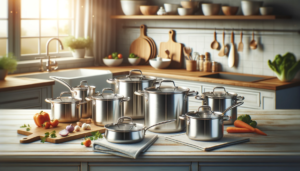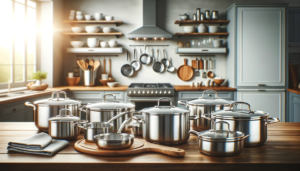Is all the hype around nonstick cookware really justified or does classic stainless steel still reign supreme in your kitchen?
Nonstick offers temporary convenience but stainless steel delivers better cooking, safety, and value over decades of daily use.
Let’s dive into comparing stainless steel vs nonstick cookware across durability, cooking benefits, maintenance and more to see why stainless still wins for serious cooks.
Stainless Steel vs Nonstick Cookware
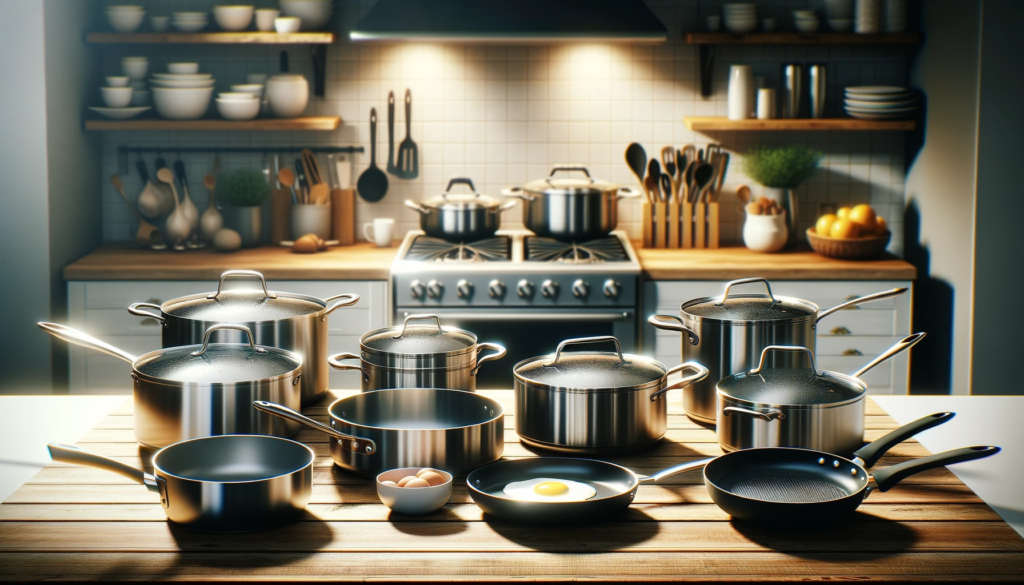
Is stainless steel or nonstick cookware superior? Stainless steel clearly wins for serious cooking and kitchen value thanks to extreme durability and lifetime performance that far exceed cost benefits of low quality disposable nonstick pans needing replacement every few years.
However, cheap nonstick still has convenience advantages for beginner cooks doing simple egg or pancake preparation occasionally.
As we’ll explore in depth across various key factors below, stainless steel’s lifetime cooking enjoyment and unmatched versatility cement it as the definitive cookware foundation for any kitchen compared to short-lived nonstick.
Durability and Lifespan
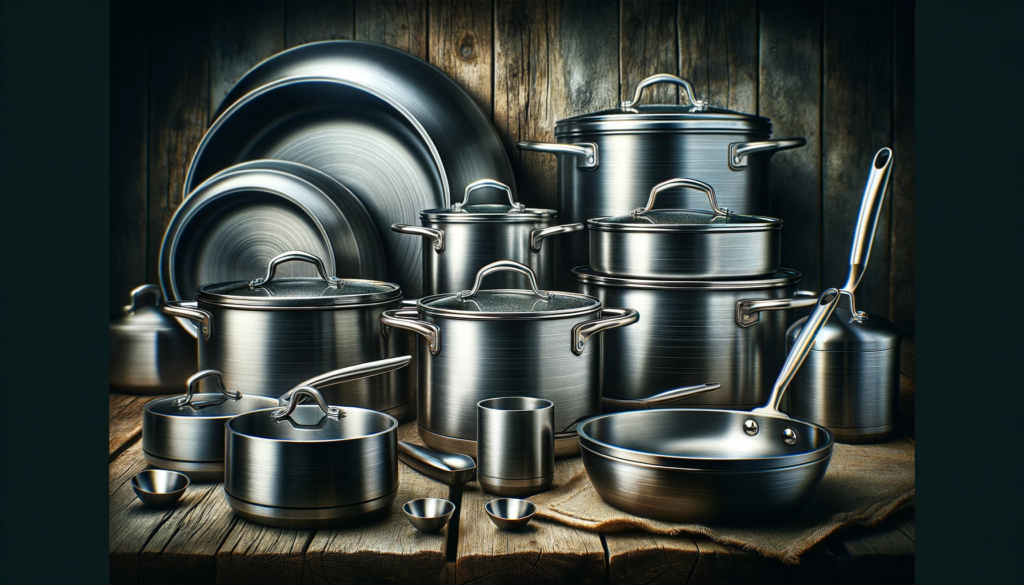
Stainless steel cookware is well renowned for its extreme durability and ability to last for decades with proper care and maintenance.
The stainless steel itself possesses anti-corrosive properties that enable it to withstand heavy usage without degrading.
Stainless steel contains chromium which reacts with oxygen to form a protective layer of chromium oxide on the surface.
This chromium oxide outer layer is able to resist rust and staining even with exposure to moisture over many years ofkitchen use.
As long as stainless steel cookware is used properly and not abused, it can serve faithfully for generations.
For example, avoid leaving empty stainless steel pans sitting at high temperatures for long periods which can compromise the shape and cause warping.
Also use some elbow grease or non-scratch scrubbers when cleaning stainless steel rather than expecting residues to slide off as easily as a nonstick surface.
But with some basic proper care, your stainless steel pots and pans can easily outlast most other types of cookware on the market today.
Many families pass down heirloom sets for decoration even if home chefs upgrade to newer stainless steel models.
Nonstick cookware on the other hand eventually loses its nonstick surface coating and needs to be fully replaced.
This replacement cycle is especially rapid for poorer quality nonstick pots and pans incorporating inferior coatings.
Higher end name brands using the latest generation PFOA-free (more details later) formulations claim lasting up to 10x longer than cheaper varieties, but all nonstick coatings wear out nevertheless.
Depending on cooking frequency and the quality of the nonstick coating application itself, the practical lifespan usually spans between three to five years of moderate usage before the finish becomes compromised enough that food starts noticeably sticking.
This wear down process occurs even faster if metal cooking utensils are used which can rapidly scrape away the material, or if the pans are subjected to dishwasher cycles rather than hand washing.
While the base construction of nonstick cookware – typically stainless steel or aluminum alloy – will keep functioning fine for decades, the nonstick element itself necessitates continual replacing or reapplying fresh coating layers.
Without intact nonsticking properties, dirty cleanup and subpar cooking experiences usually prompt buyers to replace the whole pan.
Cooking Performance
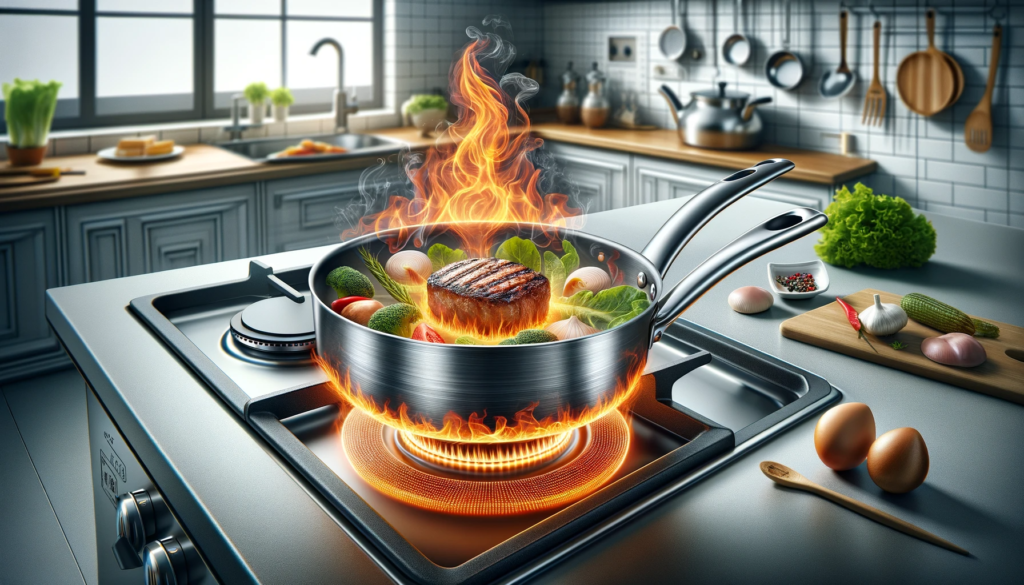
Stainless steel cookware is often praised by experienced home cooks for its reliable all around cooking performance.
The durable stainless steel construction offers excellent heat distribution properties.
Stainless steel metal is able to spread and conduct heat quickly and evenly across the entire bottom cooking surface as well as up the sides of pots and pans.
This gives much more uniform heating and cooking compared to materials like aluminum or copper alone that create intense hot spots.
The even heat distribution lends stainless steel well to cooking tasks requiring controlled simmering such as making sauces from scratch.
It also shines for activities like frying eggs over easy, flipping pancakes, sauteeing vegetables where you want an all over consistent cooking surface to prevent burning.
For example with fried eggs, the egg white will set evenly in a lightly oiled stainless pan instead of browning more rapidly in certain spots leading to tearing of the delicate white.
Gentle even heat also lets you melt chocolates or cook heavy cream based recipes without scalding the delicate dairy.
In addition to even heat properties, stainless steel can also be used very effectively for high heat searing, stir frying meats, caramelizing vegetables and more.
The key for the highest heat cooking is having adequate oil or liquid in the pan rather than trying to cook something dry over max flame.
But with sufficient fat/moisture to prevent food sticking excessively, that durable stainless surface gives the fond development and tasty sear marks that skilled chefs strive for in a commercial kitchen.
Compared to nonstick, stainless steel can reach hotter maximum temperatures for the Maillard reactions.
Moving to nonstick cookware, the major advantage is convenience thanks to the signature nonstick surface that prevents food from adhering while cooking in most scenarios.
This effect stems from the layered polymeric coating applied to the cookware surface.
When new and intact, a tiny fried egg will slide around the pan instead of rigidly sticking.
Other items prone to stick stubbornly without ample grease like fish filets, pancakes, and cheese will also cook and release much more easily from nonstick pans.
This introduces forgiveness for beginner cooks along with quick cleanup convenience.
However, nonstick surfaces lose their nonsticking magic with accumulated usage, abrasion, and deterioration over time – hence the regular need for replacement.
And limitations exist even on brand new nonstick pans.
At sufficiently high temperatures, the nonstick polymers start losing integrity leading food to stick despite the coating.
This means nonstick isn’t well suited to aggressive activities like searing thick pork chops or charring bell peppers that rely on ripping hot heat.
While modern generation coatings claim stability up to 400-500F now, they still can’t match stainless steel for reaching maximum temperatures.
Ease of Cleaning and Maintenance
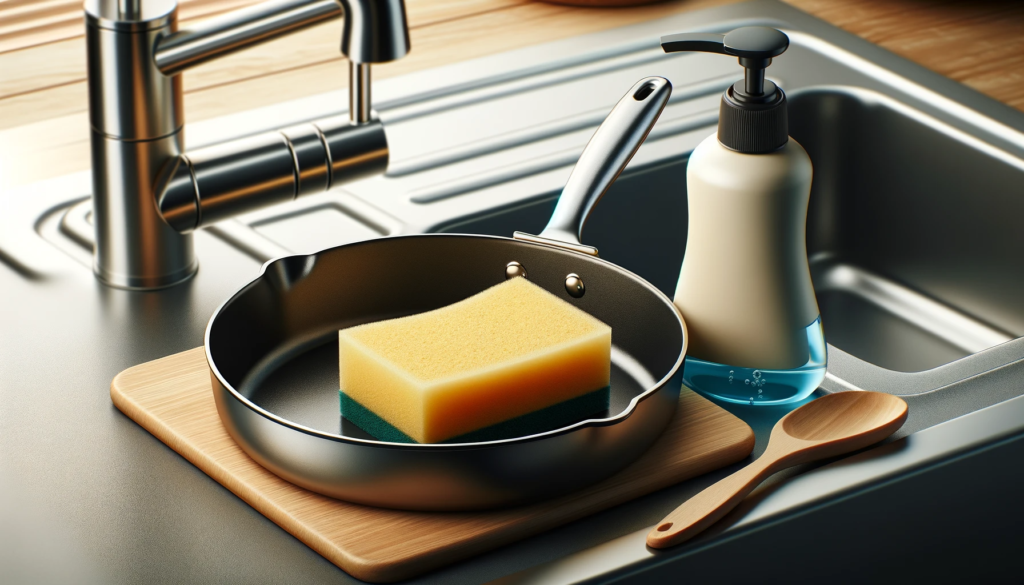
Without a doubt, nonstick cookware delivers exceptional convenience when it comes to post-cooking cleanup tasks – at least while still fresh and intact.
A simple rinse or fast wipe with a damp sponge is all it takes to clean a nonstick pan after frying eggs or sauteeing vegetables since food does not adhere at all while cooking.
Compared to scrubbing caked on residue from stainless steel, nonstick lets cooks spend less time cleaning and more time enjoying freshly cooked meals with family.
Some polymer coatings even have hydrophobic properties causing water to bead up easily taking any loose debris with it.
However, easy wipe-down properties don’t last forever without ongoing maintenance.
Over months and years of repeated cooking and cleaning cycles, the nonstick surface slowly wears away especially if abrasive scouring pads are used excessively in efforts to clean any stuck bits.
Once small patches of coating fade, sticky buildup becomes rapidly worse requiring eventual reapplication of nonstick layers.
While stainless steel proved more stubborn than nonstick for cleaning freshly made meals, its uncoated surface has unique advantages for tackling messes from meals gone wrong.
If food accidentally gets charred and burnt hard onto the pan bottom, stainless steel’s roughness lends itself perfectly for attacking with abrasives.
A good stainless steel scrub brush or scraper can remove even severely baked on food residue without damaging the underlying metal at all since there is no coating to protect.
This makes even the most discolored and messy stainless pan look freshly new after some elbow grease.
When it comes to general maintenance over many years, stainless steel is also clearly lower demanding compared to nonstick.
Without a delicate surface coating, stainless steel pots and pans basically just need the occasional metal polish or shine restoring product to keep up appearances rather than extra delicate pampering required by nonstick.
Stainless steel pans and lids containing no electrical components can be casually popped in the dishwasher daily without worry of degrading performance or lifespan.
Detergents, high heat drying cycles, and general roughness inside a dishwasher will rapidly compromise thinner nonstick layers though.
For nonstick cookware, delicate hand washing is mandatory to reach anywhere close to the expected 3-5 year lifespan.
Instructions explicitly warn against metal utensils that scratch away coating with each stir, abrasive scouring products that strip away the slick barrier, harsh detergents that penetrate porous zones, and dishwasher cycles which subject nonstick to caustic solutions and moisture.
While rinsing nonstick is simpler day-to-day, the cumulative careful handling gets tedious for cooks wanting to focus more on enjoying kitchen creativity.
Health and Safety Concerns

Stainless steel cookware and serving tools rightfully earn high marks when it comes to health and safety considerations.
As a pure metal alloy containing iron, chromium, nickel and occasionally molybdenum or titanium, stainless steel is highly inert and does not react with food or liquids during cooking processes.
No coatings, paints, nonstick layers exist with stainless steel to risk flaking off into food either.
This makes stainless an ideal surface for coming into direct contact with cooking food without risk of health issues short or long term, presuming quality construction.
Multi-clad stainless steel does sandwich an aluminum or copper core layer to enhance heating properties.
But only the stainless steel interior comes into contact with food preventing heavy metal leaching concerns.
Avoid lower cost stainless with a cladded bottom though; lower heat resistance of the external disk material risks separation or warping that exposes underlying metal alloys to food.
With those exceptions noted, stainless steel earns top marks for being an ultra neutral material when it comes to human health safety.
For nonstick cookware, there have been health issues crop up repeatedly over the decades as more understanding develops around polymer decomposition, fumes, and flaking at高 temperatures.
Most infamously, PFOA (perfluorooctanoic acid) used to produce the original Teflon branded nonstick turned out to have serious health consequences for both factory workers producing pans as well as end consumers cooking over years.
PFOA was phased out under EPA stewardship starting in 2015 due to toxicity concerns as a likely carcinogen in animal studies.
All modern nonstick now advertises PFOA-free formulations incorporating alternative polymers like PTFT launched by Chemours.
Brands boast safety testing and using exclusively FDA approved food-contact level materials.
However legitimate questions still remain around nonstick cookware safety in various scenarios that the slick marketing copy glosses over.
For example overheated empty nonstick pans reaching temperatures exceeding 500F+ can still decompose and release organofluorine compounds detected as faint petrol/solvent odors.
While generally unpleasant smelling rather than acutely hazardous, some sources recommend caution around inhaling fumes from severely burnt nonstick.
There are also open questions around potential for microscopic nonstick coating particles to flake off during cooking into food later ingested and passing through digestive tracts.
Some consumer groups emphasize avoiding already scratched/damaged nonstick interiors prone to heightened flaking to err conservatively on exposure.
While not definitive and still undergoing study, some cookware experts hedge bets and suggest using nonstick minimally just for delicate tasks like eggs while relying on inert stainless steel for general cooking use.
Overall nonstick vs stainless steel weighs clearly towards stainless steel cookware coming out ahead for health & safety considerations in nearly all scenarios.
While modern nonstick avoids clearly known serious toxins like PFOA, question marks still populate around risks associated with overheating and use over time.
For families focused on cooking healthy homemade meals, stainless steel delivers welcome peace of mind.
Cost Considerations Over Time
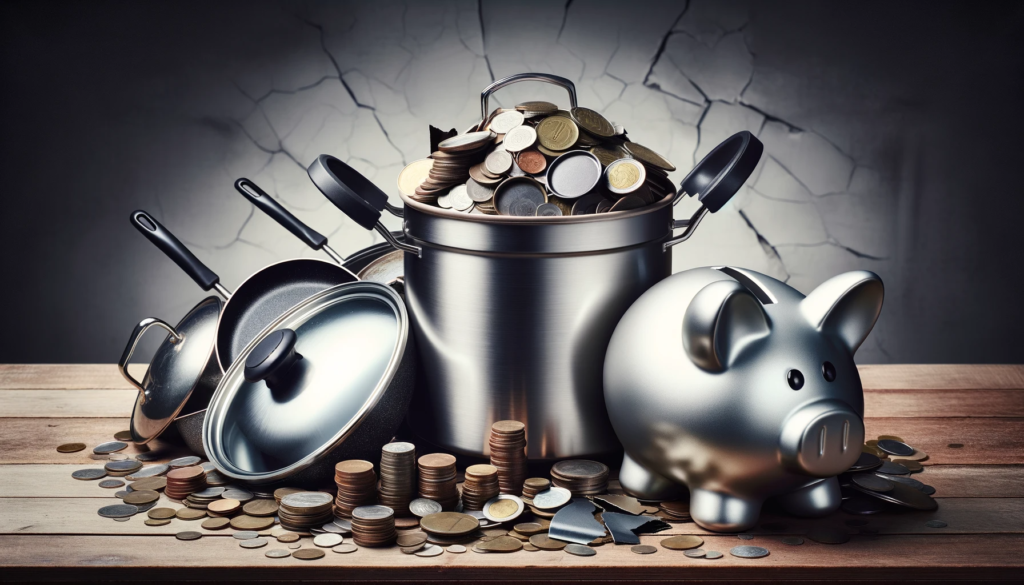
Upfront sticker price alone makes nonstick seem the clear economical winner.
Complete nonstick cookware sets with pots, pans and utensils routinely sell for under $100.
Even a single high quality stainless steel skillet from premium brands can run upwards of $50.
With a $20 cheap nonstick pan functioning fine for low intensity eggs or reheating compared to a designer stainless model, money savings seem obvious going the nonstick route.
Especially for younger adults outfitting a first apartment kitchen on tight budget or college students crammed into tiny dorms, low cost nonstick makes logical sense.
But when factoring in the entire lifespan, stainless steel delivers substantially better value over decades of daily cooking.
Those inexpensive nonstick pots and pans need replacing every 3 years or so as surfaces wear down to the bare metal and food starts clinging everywhere during cooking.
Replacing an entire cookware set twice a decade definitely offsets the higher upfront cost.
Premium brand stainless steel cookware on the other hand gets passed down generation to generation as precious heirlooms rather than ending up discarded with the trash every few years.
The durable cooking performance often improves over time too as seasoning layers accumulated through years of cooking infuse into microscopic pores on stainless interiors.
Frying eggs and whipping cream sauces becomes easier over decades helping even vintage stainless steel function like naturally nonstick.
Quality stainless steel can literally serve faithfully for 50+ years whether for amateur home chefs or demanding professional kitchens.
That unbeatable lifetime value more than outweighs sticker shock comparing shiny new boxes side by side at the store.
Calculated on a per year basis factoring multiple nonstick replacement purchases, stainless steel delivers substantially lower cost along with better cooking.
Aesthetic Qualities and Appearance Over Time
Polished stainless steel cookware delivers unmatched beauty with fashionable style suitable for cooking in open entertainment floorplans or hosting elegant dinner parties.
The commercial grade shine additionally projects an image of capable skill in the kitchen.
Stainless also maintains its sophisticated professional looks over decades of daily use with occasional buffing compared to nonstick which appears progressively worse and ragged through wear damage accumulating over months and years.
The mirror finish of fine stainless pans stems from extensive polishing and buffing during manufacturing that smoothes microscopic wrinkles down to a beautiful unbroken shine able to reflect backgrounds like a liquid metal surface.
Quality brand stainless cookware enhances appearances further by ensuring seamless joins between pieces, tapered elegant edges, consistently formed handles, and avoiding surface irregularities that stubbornly retain water droplets or cooking grime.
Beyond dazzling looks straight out of box, stainless also ages wonderfully developing darker amber and gold hints over years of use called “patina”.
Much like a vintage leather jacket or lovingly oiled cutting board, old stainless pots and pans carry an alluring character and history absent from shinier but disposable nonstick.
Seeing distinct hints of different meals cooked over decades enhances love of cooking as an artisan craft honed tirelessly rather than just a routine chore.
In contrast, cheaper nonstick almost universally sports a dull speckled black or dark grey color palette even when brand new.
Cursory scans of bed & bath stores unfortunately show nonstick dominates lower price points.
And rather than improving oxidation effects over time, inferior nonstick just looks progressively worse as scratches and coating wear accumulate.
Flaking around edges also worsens after just a few years.
While nonstick interiors admittedly maintain clean appearances for the first few months, visible degradation soon takes over.
Durable nonstick coatings like titanium reinforced Teflon do better than generic supermarket variety, but still inevitably show use over time.
By year three, signs of worn out coating are obvious with streaky appearances and grease no longer beading up nicely during cleaning.
At that stage the whole pan looks grimy and demands replacement to regain decent aesthetics matching the original out-of-box sheen of fine stainless cookware.
Conclusion
In conclusion, stainless steel cookware outpaces nonstick options across durability, cooking performance, long term value, and aesthetic qualities.
While nonstick initially seems affordable and convenient, stainless steel delivers better cooking with unmatched lifetime reliability.
For your health, wallet, cooking enjoyment, and stylish kitchen, stainless steel is the clear winner.

